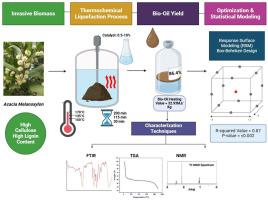Acacia Melanoxylon: A pathway from an invasive species to renewable bio-oil via thermochemical conversion
IF 5.8
2区 生物学
Q1 AGRICULTURAL ENGINEERING
引用次数: 0
Abstract
This article presents a comprehensive modelling approach for the liquefaction of mixed Acacia Melanoxylon biomass. The proposed model combines a statistical method that uses quantitative data from appropriate experimental designs to determine and simultaneously solve multivariate equations, simulating the complex thermochemical processes that occur during the liquefaction process, to predict the yield of the process. It considers crucial factors such as reaction temperatures (100, 135, 170 °C) and residence time (30, 115, and 200 min), as well as catalyst concentrations ranging from 0.5 % to 10 % (w/w). The optimal conditions for bio-oil yield were 86.42 %, with a higher heating value (HHV) of 32.93 MJ/kg, while the HHV of fresh biomass was 14.07 MJ/kg. A response surface methodology (RSM), Box-Behnken design, was used to optimize the liquefaction process. The independent variables were selected as the reaction temperature, reaction time, and catalyst concentration. The obtained model presented a high adjusted R-squared (0.944) and a good p-value (less than 0.002). Fourier Transformed Infrared (FTIR), thermogravimetric analysis (TGA), and nuclear magnetic resonance (NMR) were used to characterize the products. Additionally, scanning electron microscopy (SEM) was used to assess the impact of the morphological changes on the solid samples' surface area. By harnessing biomass thermochemical liquefaction, this study not only unlocks the valorization potential of invasive species but also offers an opportunity to validate a sustainable and clean process for upcycling such woody matrix.

黑刺槐:入侵物种通过热化学转化转化为可再生生物油的途径
本文提出了一种综合建模方法,用于混合刺槐生物量的液化。该模型结合了统计方法,利用适当实验设计的定量数据来确定并同时求解多元方程,模拟液化过程中发生的复杂热化学过程,以预测该过程的产量。它考虑了关键因素,如反应温度(100,135,170°C)和停留时间(30,115和200分钟),以及催化剂浓度范围从0.5%到10% (w/w)。最佳产油条件为86.42%,热值(HHV)为32.93 MJ/kg,新鲜生物质的HHV为14.07 MJ/kg。采用响应面法Box-Behnken设计对液化过程进行了优化。自变量为反应温度、反应时间和催化剂浓度。该模型具有较高的校正r²(0.944)和较好的p值(小于0.002)。采用傅里叶变换红外(FTIR)、热重分析(TGA)和核磁共振(NMR)对产物进行了表征。此外,利用扫描电子显微镜(SEM)来评估形态变化对固体样品表面积的影响。通过利用生物质热化学液化,本研究不仅释放了入侵物种的增值潜力,而且为验证可持续和清洁的木质基质升级循环过程提供了机会。
本文章由计算机程序翻译,如有差异,请以英文原文为准。
求助全文
约1分钟内获得全文
求助全文
来源期刊

Biomass & Bioenergy
工程技术-能源与燃料
CiteScore
11.50
自引率
3.30%
发文量
258
审稿时长
60 days
期刊介绍:
Biomass & Bioenergy is an international journal publishing original research papers and short communications, review articles and case studies on biological resources, chemical and biological processes, and biomass products for new renewable sources of energy and materials.
The scope of the journal extends to the environmental, management and economic aspects of biomass and bioenergy.
Key areas covered by the journal:
• Biomass: sources, energy crop production processes, genetic improvements, composition. Please note that research on these biomass subjects must be linked directly to bioenergy generation.
• Biological Residues: residues/rests from agricultural production, forestry and plantations (palm, sugar etc), processing industries, and municipal sources (MSW). Papers on the use of biomass residues through innovative processes/technological novelty and/or consideration of feedstock/system sustainability (or unsustainability) are welcomed. However waste treatment processes and pollution control or mitigation which are only tangentially related to bioenergy are not in the scope of the journal, as they are more suited to publications in the environmental arena. Papers that describe conventional waste streams (ie well described in existing literature) that do not empirically address ''new'' added value from the process are not suitable for submission to the journal.
• Bioenergy Processes: fermentations, thermochemical conversions, liquid and gaseous fuels, and petrochemical substitutes
• Bioenergy Utilization: direct combustion, gasification, electricity production, chemical processes, and by-product remediation
• Biomass and the Environment: carbon cycle, the net energy efficiency of bioenergy systems, assessment of sustainability, and biodiversity issues.
 求助内容:
求助内容: 应助结果提醒方式:
应助结果提醒方式:


